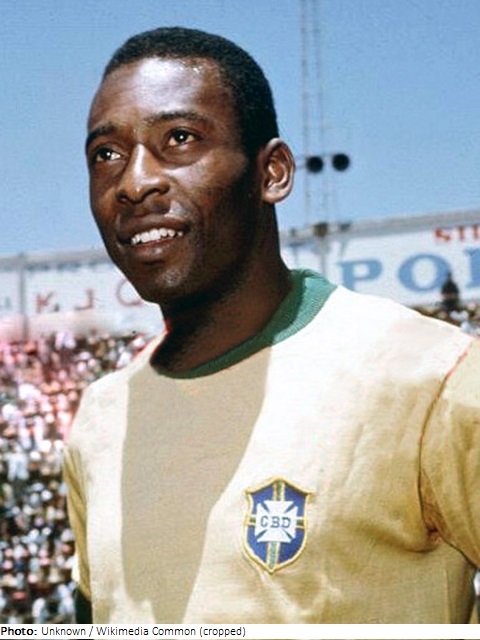Pelé

Biographical information
| Roles | Other |
|---|---|
| Sex | Male |
| Full name | Edson "Pelé"•Arantes do Nascimento |
| Used name | •Pelé |
| Other names | Edison Arantes do Nascimento |
| Born | 23 October 1940 in Três Corações, Minas Gerais (BRA) |
| Died | 29 December 2022 (aged 82 years 2 months 6 days) in São Paulo, São Paulo (BRA) |
| Affiliations | Santos FC, Santos (BRA) / New York Cosmos, New York (USA) |
| NOC |  Brazil Brazil |
Biography
It was said that Muhammad Ali was at one time the most recognisable person on earth, but Edison Arantes do Nascimento, or Pelé as he was better known, also achieved that status.
Pelé came from very humble beginnings to rise to become a footballing megastar. His father Dondinho was a good standard footballer but never quite made it to the top and, when a knee injury ended his career, the family’s fortunes declined and Pelé was forced to work as a part-time shoe-shine boy from the age of seven. His mother never wanted him to follow in his father’s footsteps and play football, but by the time he was a teenager Pelé showed so much talent that he was sought after by big clubs in the Rio and São Paulo areas. His parents were persuaded to let him sign for Santos and, when he arrived at his new club, it was proclaimed that the 15-year-old would one day be “the greatest footballer in the world”. They were proved right.
Pelé burst onto the World stage as a 17-year-old at the 1958 FIFA World Cup in Sweden. He missed the first two games through injury yet, despite his age, senior members of the team called for the manager to play him in their last group game against the Soviet Union. He was selected, and became the youngest ever player in the history of the tournament. He went on to become the World Cup’s youngest scorer in the 1-0 quarter-final victory over Wales, the youngest ever hat-trick scorer in the semi-final win over France, and then the youngest ever finalist, and scorer, when he netted twice in the 5-2 won over the hosts. He scored six goals in his first four World Cup games.
Pele just kept on breaking records after that and, as of the 2020 tournament, he remained the only person to have won three World Cup winners medals, having won again in 1962 and 1970. Some of Pele’s World Cup goals and passes rank among the best ever seen in the competition. Between 1957, when he made his début at 16, and 1971, Pelé scored 77 goals for Brazil in 92 games.
After his 1958 appearance, Santos was inundated with requests from wealthy Italian clubs to sign Pelé but the “Not for sale” sign soon went up and he played nearly all of his club football in Brazil until retiring from Santos in 1974. He played 1,116 games for Santos and won many titles including the Campeonato Brasileiro Série A six times, the São Paulo Campeonato Paulista 10 times, the Copa Libertadores in 1962 and 1963, and the Intercontinental Cup, also in 1962 and 1963.
He came out of retirement in 1975 for a bumper multi-million-dollar end to his career with New York Cosmos. His final season with Cosmos was in 1977 when the won the NASL Soccer Bowl. His very last game was a friendly between Santos and Cosmos in October 1977 when Pelé played half the match for each club. He scored his 1,283rd, and last, senior goal in what was his 1,367th game.
After his playing days, Pelé was a worldwide ambassador for football and won honours and accolades including, in 1999, being named the “Athlete of the Century” by the IOC, despite never competing at the Olympics. The following year he was jointly named “FIFA Player of the Century” with Diego Maradona. He was honoured in all corners of the globe including the United Kingdom, where he received an Honorary Knighthood. In 2016 he became an Olympic Order recipient (Silver)
Pelé was named after the inventor Thomas Edison, although his parents spelt his name wrong on his birth papers, and called him Edson. How the name Pelé came about remained a mystery but, no matter what, the boy from such humble beginnings transformed Santos from a small provincial club into an internationally-known team as he became quite simply, the “World’s Greatest Footballer” – as was predicted when he was 15.
Other participations
| Games | Role | NOC | As | |
|---|---|---|---|---|
| — | Other |  BRA BRA |
Pelé |
List mentions
- Listed in Olympic Order Recipients (2016 (Silver))